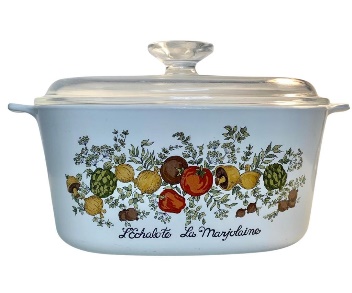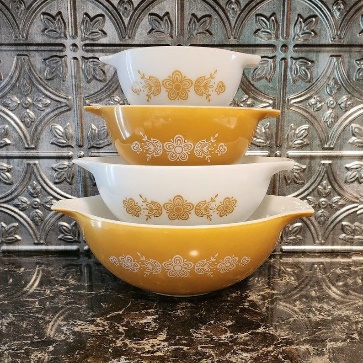Rummage through your mother’s cookware and you may discover a gold mine.
That old CorningWare baking dish languishing in the back of the cupboard could be worth a small fortune. With the 1970s retro revival in classic cookware, these little numbers are fast becoming collectible. The familiar white casserole dish is making a comeback in a big way, but the more rare the pattern, the higher the price at auction.
Perhaps the most recognizable CorningWare design is the pretty blue ‘Cornflower’ pattern. Because this pattern is so common, however, it remains more widely available and is less valuable to collectors. These versatile dishes are still excellent to own and cook with, as the ceramic cookware can be used on the stove and in the oven.
Valuable CorningWare patterns

1. Spice of Life (1972-1987)
The ‘Spice of Life’ range is widely regarded as the second-most common CorningWare pattern after Cornflowers. But, certain models in this range can fetch high dollars when they are in good condition with the original lid. Only the earliest dishes had the model name inscribed below the pattern. Rare model names include ‘L’echalote La Marjolaine’ and ‘Le Romarin’.
2. Floral Bouquet (1971-1975)
One of the most rare designs is the ‘Floral Bouquet’ pattern which was manufactured for a very short time period between 1971 and 1975. The pattern features the outlines of flowers in orange, black and blue with pale green leaves. A second, limited edition version the Floral Bouquet design was released in 1971 and features the same familiar flower design but on a yellow, rather than white, background.
3. Wildflower (1977-1984)
The “Wildflower” pattern, which is was made between 1977 and 1984 and is harder to find now. The design features bright red poppies surrounded by yellow daises and small blue flowers. The rare Wildflower pattern is one of the most coveted CorningWare patterns.
Don't Throw Out Grandma's Pyrex—Those Casserole Dishes Could Be Worth Real Money

You can’t hang around estate sales for very long without eventually running into a piece of Pyrex. Here's everything you need to know to collect vintage Pyrex like a pro—and figure out if you've got a goldmine in your kitchen cabinet.
Knowing how to tell if Pyrex is vintage is an important skill. Start by looking for the Pyrex identification mark or logo. Then look at the pattern and shape to see if they match up with designs from decades past. Also, older pieces from the 1950s and before will be thinner than modern ones, and very old, clear glass pieces may have a slight amber hue.
Bowls in fair to poor condition may go for a few dollars at a thrift store or yard sale, but a highly sought-after pattern in excellent condition may reach as high as a few hundred dollars Complete nesting sets in almost any pattern can fetch over $100 on the low end and often into the several hundred range or more.
How to Tell If Pyrex Is Vintage Using Patterns and Colors
The pattern is the first thing to check out on your Pyrex. Pyrex glassware made by Corning Glass Works was originally clear. In the mid-1940s,
however, colored and patterned bowls and casserole dishes began appearing and are what many collectors seek today. Pastel shades of blue,
green, pink, and more became common, although bright primary colors also had their time along with more muted earth tones.
These are just a few notable ones:
• Primary colors (red, yellow, blue, plus green) were popular from 1945 to 1950.
• Butterprint farm scenes with male and female figures, roosters, and plants decorated Pyrex from the late 1950s to late 1960s.
• Gooseberry, featuring the berries on vines with leaves, was popular in the late 1950s through most of the 1960s.
• Town and Country designs featured abstract star-like motifs in the 1960s.
• New Dot featured large colorful dots on white in the late 1960s.
• Butterfly Gold had a floral pattern in the 1970s.
• Autumn Wheat" showcased sheaves of wheat in the 1980s.